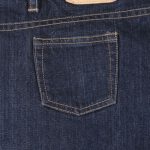Denim is prized for its strength, durability and versatility. Even after a century, little has changed regarding its construction. Denim is still made using the same process involving passing the weft under two or more cotton warp threads. Whether it’s used for jeans, shirts, jackets or other garments, denim is arguably one of the best all-around materials. But if you want to preserve the integrity of your denim apparel, there are a few things you should know. In this blog post, we’re going to explore some essential tips on how to care for denim.
#1) Don’t Use Bleach
Unless you’re trying to achieve a faded appearance, it’s best to avoid using bleach when washing your jeans and other denim apparel. Bleach is highly effective at making white clothes brighter. When used on indigo, light blue and other non-white garments, however, it can cause spots of discoloration. Furthermore, bleach has been known to damage the cotton threads in denim. So, even if you have a pair of white jeans that you want to make brighter, you should probably use an alternative color-brightening agent instead of bleach.
#2) Avoid Dry Cleaning
Some people automatically assume that dry cleaning is the safest and most effective way to clean their denim garments. After all, dress shirts often say “dry clean only,” so conventional wisdom may lead you to believe this statement is true. In reality, though, dry cleaning is a harsh process that exposes garments to a plethora of chemicals. The term “dry cleaning” is somewhat confusing, because it’s not completely dry. While it doesn’t involve the use of water, it does involve the use of cleaning chemicals — and some of these chemicals may deteriorate and damage denim fabric.
#3) Don’t Let Your Jeans Drag on The Ground
When wearing jeans or other styles of denim pants, don’t let the bottom drag on the ground. This may seem harmless enough, but it can cause major damage to the denim fabric. When the bottom of your denim jeans drag on the ground, the fabric will gradually wear away. In some cases, only minor fraying may occur. In other cases, the bottom of the denim jeans may become completely unraveled. Regardless, damage such as this is easily prevented by ensuring your jeans don’t drag on the ground. This means wearing the right shoes with your jeans, as well as choosing the right size jeans.
#4) All-Denim Construction
Don’t assume that all jeans are made of 100% denim. If you look at the label, you’ll notice that many jeans contain other fabrics or materials. For instance, it’s not uncommon for jeans to contain both denim and polyester. The addition of polyester allows the jeans to stretch and flex, which can make them more comfortable. As a result, however, this also makes them more susceptible to damage. So, if you want your jeans to last and withstand the hands of time for countless years to come, stick with 100% denim jeans.
#5) Use a Gentle Detergent
There are dozens of different laundry detergents on the market, many of which contain harsh chemicals. Like dry cleaning, these harsh chemicals can help to remove stains and clean stubborn dirt. However, they can also damage the fabric of your denim garments. This is why it’s a good idea to choose a gentle detergent. So, what should you do if a gentle detergent isn’t removing a particular stain on your denim jeans? Rather than switching to a new detergent, try spot cleaning the stained area with a laundry pre-treatment product.
#6) Turn Jeans Inside Out Before Washing
Try to get into the habit of turning your jeans inside out before washing them. Many fashion experts and textile professionals say this is the best way to wash jeans, as it protects the exterior from hot water and detergent. As you probably know, only one side of denim contains color. When denim is made, the wept-faced twill weaving leaves one side with color (usually blue), while the other side is dominated by white weft threads. Turning your jeans inside out before washing them protects the colored side of the denim from damage.
#7) Measure Your Detergent
Do you measure the amount of detergent you use to wash clothes? If not, you aren’t alone. Most people rarely, if ever, measure their detergent. Instead, they pour a cup into the washing machine and hit the “on” button. You have remember, though, that many laundry detergents are concentrated, and using too much increases the risk of damage to your garments. To protect your denim garments from such damage, measure out the appropriate amount of detergent.
#8) Wash Less Frequently
Who says you need to wash your jeans every time you wear them? Normally, washing your clothes after each use is a good way to keep them clean. However, it also wears down the fabric, increasing the risk of damage and degradation. This doesn’t necessarily mean that you should avoid washing your jeans for months on end. Rather, consider washing them once every other time you wear them. This alone will prove useful in extending the life of your jeans, allowing you to get a little more use out of them.
#9) Choose Quality Denim
It’s also recommended that you choose high-quality denim jeans and garments. Assuming you shop here at MakeYourOwnJeans, you can rest assured knowing that you are getting the highest quality denim on the market. All of our jeans and products are made with premium denim. Furthermore, we offer custom sizing at no additional charge.
#10) Check the Care Label
Finally, check the care label on your jeans and denim garments for specific instructions on how to clean and care for them. You can usually find the care label inside the waistband. Here, the manufacturer will include step-by-step instructions on how to clean and maintain the garment. Being that different manufacturers use different construction techniques, you should always check and follow the care label.












